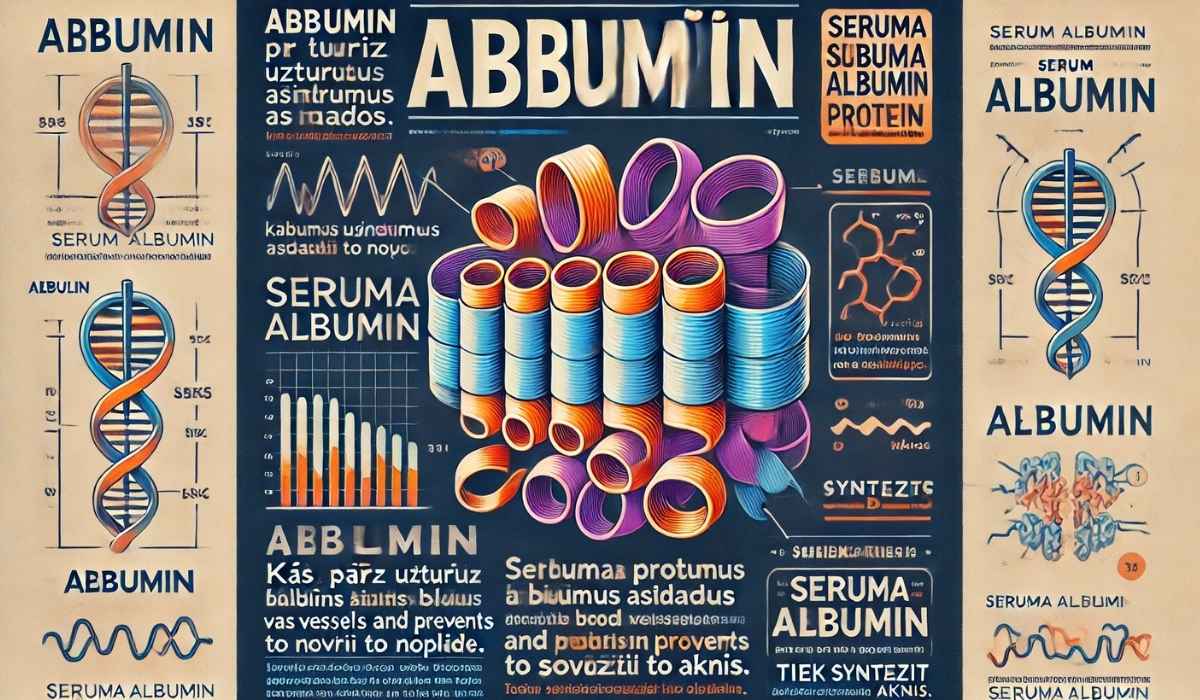Albumīns are one of the most essential proteins in biology, present in both animals and plants, and they play a crucial role in maintaining health, regulating physiological functions, and supporting life. They are most famously found in human blood plasma, where they are the most abundant protein, but they also occur in foods such as eggs, milk, and seeds. The remarkable versatility of albumīns stems from their structure, which allows them to bind and transport a variety of molecules, as well as their unique biochemical properties that support homeostasis. Because of their importance, albumīns have been extensively studied in medicine, nutrition, and biochemistry, making them both a subject of academic interest and a critical biomarker in healthcare diagnostics.
Structure of Albumīns
Albumīns are simple, globular proteins made up of a single polypeptide chain of about 585 amino acids. Their folding pattern is dominated by α-helical segments that create a compact, stable three-dimensional shape. This structure is held together by multiple disulfide bonds, which provide resilience under varying physiological conditions such as changes in pH and temperature. One of the most remarkable aspects of albumīns is their ability to bind reversibly to numerous ligands. This property is made possible by the presence of multiple binding sites with diverse chemical affinities, making albumīns highly adaptable in their transport roles. In humans, serum albumin is synthesized in the liver and secreted into the bloodstream, where it circulates freely and performs its critical tasks.
Physiological Roles and Mechanisms
Albumīns have a multifunctional role in the human body that extends beyond mere transport. They maintain oncotic pressure, the osmotic force that keeps fluid within the circulatory system rather than leaking into surrounding tissues. This property is vital in preventing edema, a condition characterized by fluid accumulation and swelling. Additionally, albumīns serve as carriers for hormones, fatty acids, bilirubin, and various pharmaceutical compounds. By binding to these molecules, albumīns regulate their availability, distribution, and metabolism, ensuring that tissues receive substances in a controlled and steady manner. Their buffering capacity also helps maintain blood pH within the narrow range required for enzymatic and metabolic stability.
Sources of Albumīns in the Diet
Although the human body can produce albumin endogenously, dietary intake can support protein balance and liver health. Animal-derived foods are the richest sources. Egg whites, for instance, contain ovalbumin, a protein with similar structural and functional traits to human serum albumin. Milk provides lactalbumin, which plays a role in infant nutrition and whey protein products. Meats and fish supply a complete profile of amino acids, including those needed for albumin synthesis. In plants, albumin-like proteins are less prevalent but still significant; seeds such as hemp, sunflower, and pumpkin have soluble proteins that contribute to dietary intake. While plant sources are generally less concentrated in albumīns, they can still be valuable for individuals on vegetarian or vegan diets.
Albumīns in Clinical Diagnostics
In medical practice, albumin measurement is one of the most common laboratory tests because of its diagnostic value. Low albumin levels, known as hypoalbuminemia, can indicate liver disease, kidney disease, malnutrition, chronic inflammation, or acute illness. Elevated levels, though rare, can result from dehydration or certain medical interventions. Clinicians often use serum albumin levels in conjunction with other tests to assess the severity of illness and predict patient outcomes. For example, in liver cirrhosis, albumin levels help evaluate the liver’s synthetic function. In kidney disease, the presence of albumin in urine (albuminuria) is a marker of kidney damage, especially in diabetic patients.
Therapeutic Uses of Albumīns
Beyond diagnostics, albumīns are used therapeutically in clinical settings. Medical-grade human serum albumin solutions are administered to patients experiencing severe blood loss, burns, shock, or hypoalbuminemia. These infusions help restore oncotic pressure, improve blood volume, and stabilize patient condition. Because albumin can bind and carry drugs, it is also used in pharmaceutical formulations to extend drug half-life and enhance delivery to target tissues. Researchers are developing albumin-based drug carriers for cancer therapy, as its natural circulation time and biocompatibility make it an ideal delivery platform.
Role in Nutrition and Metabolism
Albumīns contribute indirectly to nutrition by ensuring the efficient transport of nutrients and metabolites in the bloodstream. In cases of protein deficiency, the body can break down albumin to provide amino acids for essential processes. However, prolonged low albumin synthesis due to malnutrition can impair recovery from illness and slow wound healing. Athletes and individuals undergoing physical training may benefit from diets rich in albumin-containing proteins to support muscle repair and maintain optimal plasma protein levels. In developing countries, inadequate albumin production due to poor protein intake remains a public health concern.
Albumīns as Antioxidants
An often-overlooked function of albumīns is their antioxidant capacity. Albumin molecules have binding sites for free radicals and reactive oxygen species, which can damage cell membranes, proteins, and DNA. By neutralizing these reactive molecules, albumīns help protect tissues from oxidative stress, a process linked to aging and chronic diseases such as cancer, cardiovascular disorders, and neurodegeneration. This antioxidant effect adds another layer to albumin’s protective role in the body, making it not just a transporter but also a guardian of cellular integrity.
Factors Affecting Albumin Levels
Several physiological and pathological factors influence albumin concentration in the blood. Severe infections, burns, trauma, and chronic diseases can all reduce albumin synthesis or increase its loss. Liver diseases impair production directly, while kidney disorders can lead to significant albumin loss through urine. Additionally, prolonged inflammation can alter protein metabolism, reducing serum albumin despite adequate dietary intake. Dehydration, on the other hand, can artificially elevate albumin concentration by reducing plasma volume. Understanding these variations is crucial for accurate diagnosis and effective treatment planning.
Future Research and Medical Potential
Ongoing research into albumīns is expanding their applications in medicine and biotechnology. Albumin-binding drugs, nanoparticle delivery systems, and engineered albumin molecules are under development for targeted therapies. In regenerative medicine, albumin coatings are used to improve the compatibility of biomaterials. Additionally, as our understanding of protein chemistry grows, synthetic biology may allow for customized albumin variants with enhanced functions for specific clinical needs. These advancements highlight that albumīns, while ancient in evolutionary terms, remain at the forefront of modern medical innovation.
Conclusion
Albumīns are far more than just a component of blood plasma; they are multifunctional proteins essential for maintaining fluid balance, transporting molecules, buffering pH, and defending against oxidative stress. Their significance extends from basic nutrition to advanced medical therapies. Understanding albumīns in detail helps not only in appreciating their biological importance but also in recognizing their role in disease prevention, diagnosis, and treatment. Whether through a balanced diet or advanced therapeutic use, maintaining healthy albumin levels is a cornerstone of human health.
Frequently Asked Questions
1. What is albumin and why is it important?
- Albumin is a water-soluble protein found mainly in blood plasma. It maintains fluid balance, transports molecules, and supports overall physiological stability.
2. Can low albumin be treated through diet?
- Yes, dietary protein intake from eggs, dairy, meat, fish, and certain seeds can support albumin production, though medical conditions may also need to be addressed.
3. What causes low albumin levels?
- Causes include liver disease, kidney disease, malnutrition, chronic inflammation, and severe illness.
4. Is albumin used in medicine?
- Yes, medical-grade albumin is used to treat burns, shock, severe blood loss, and hypoalbuminemia.
5. Are plant sources of albumin as effective as animal sources?
- Plant-based sources contain albumin-like proteins but generally in lower amounts; however, they can still contribute to overall protein intake.








